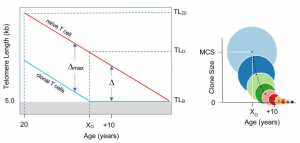A group from University of Washington, Seattle, USA, etc. has reported that age-dependent T-cell telomere length shortening affects COVID-19 severity.
https://www.ncbi.nlm.nih.gov/pmc/articles/PMC8282112/
Transient lymphopenia is a common feature of acute viral respiratory infections. The drastic and prolonged lymphopenia of COVID-19, however, is distinctive and largely stems from falling counts of T cells. Although the primary causes of this T-cell lymphopenia is still poorly understood, the decline in T-cell count in COVID-19 demands fast and massive T-cell clonal expansion, which is a telomere length (TL)-dependent issue. As hematopoietic cell TL (HCTL) shortens with age, T-cells from some older adults might lack the clonal expansion capacity required to offset the development of COVID-19 lymphopenia or recover from it.
In absence of an acute infection, the T cell turnover is slow because of the relatively long biological half-lives of naïve T cells and memory T cells in the circulation, i.e., ~ 5 years and ~ 5 months, respectively. In the face of SARS-CoV-2 infection, however, diminished TL-dependent T-cell proliferative capacity in older adults could result in a shortfall between T-cell depletion and repletion. Moreover, the clearance of SARS-CoV-2 requires clonal expansion and differentiation of naïve T cells into SARS-CoV-2 antigen-specific effector/memory (henceforth memory) T cells . Short naïve T-cell telomeres might thus limit adaptive immunity against the virus even without infection-mediated T-cell lymphopenia.
The following assumptions on T-cell replication and T-cell clone size (CS) are used in the following author’s model:
(i) T-cell TL-dependent cessation of replication is defined by a “telomeric brink” (TLB) that stops replication at 5 kilobases, (ii) TL of a naïve T cell at age 20 years (TL20) progressively shortens at a rate g of 0.03 kb/year until it reaches the TLB, (iii) In exponential growth, a single naïve T cell can generate a maximal CS (MCS) of ~ 106 (one million) memory T cells through ~ 20 replications (Nmax), (iv) the maximal TL shortening due to clonal expansion is defined as Δmax, (v) Due to age-dependent TL shortening, a naïve T- cell TL reaches the “telomeric onset” (TLO = 6.4 kb) at “age of onset” (XO), (vi) Most memory T cells are formed in response to new antigens during childhood and early adulthood.

TL20 = TL at age 20 years,
TLB = Telomeric brink, stopping cell replication,
TLO = TL at onset of clone size limitation,
XO = Age in years when TLO is reached,
MCS = Maximal clone size (~106 T cells),
Δmax = TL shortening required for achieving MCS (~1.4kb)
In conclusion, the TL effect on naïve T-cell clonal expansion probably influences the outcome of SARS-CoV-2 infection, because it becomes difficult to supply enough amount of T cell clone size with aging (with shortening TL).
